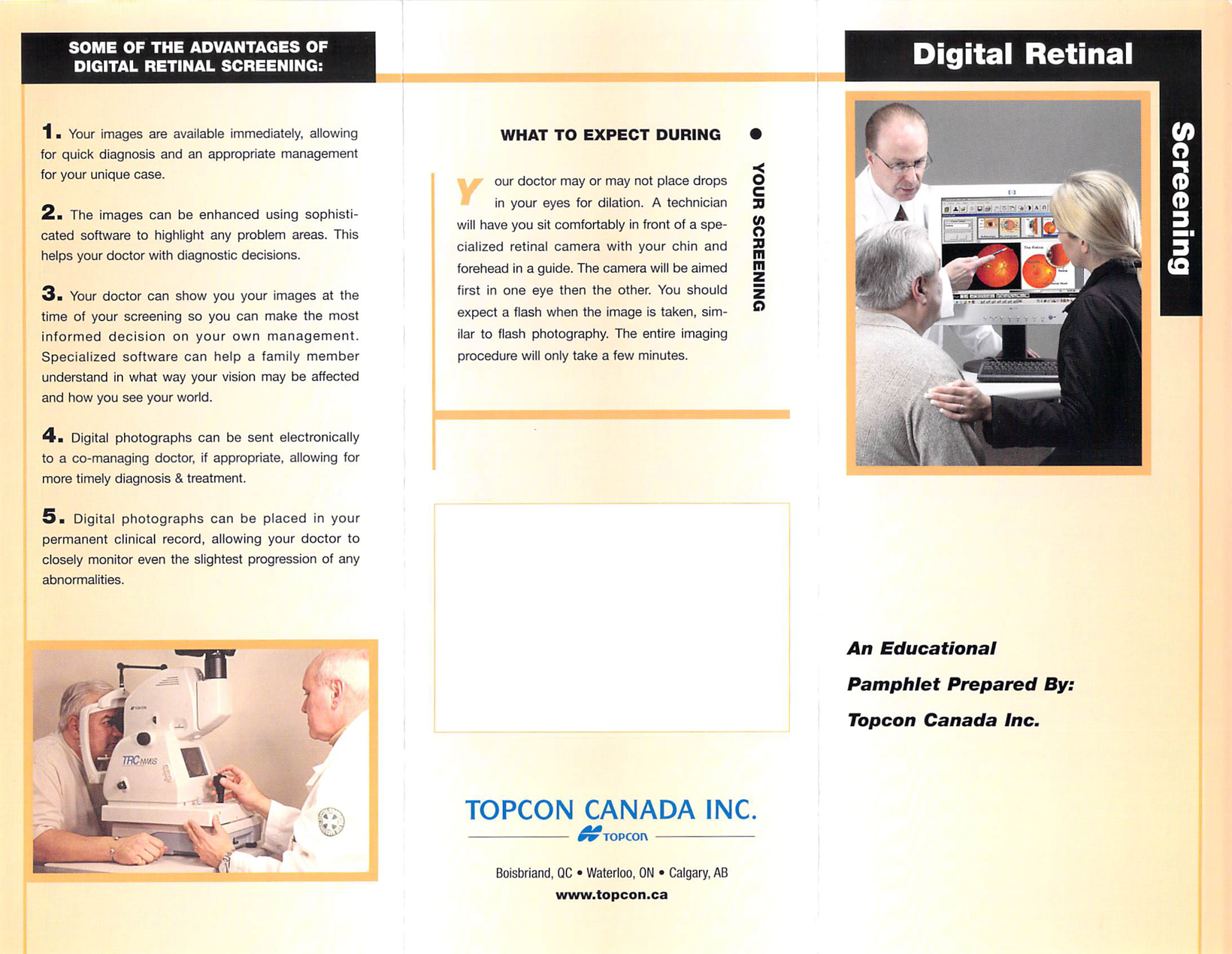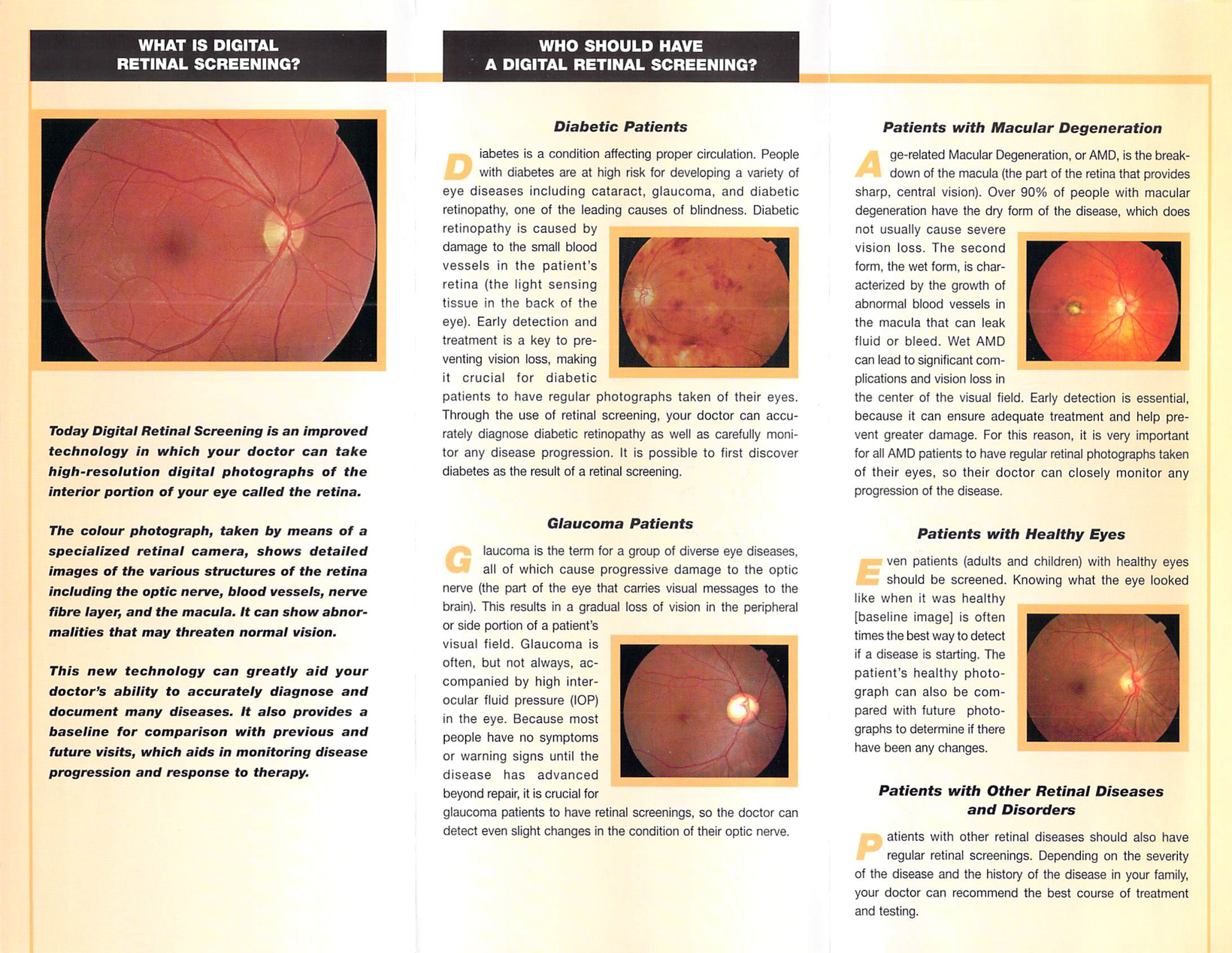

SOME OF THE ADVANTAGES OP
DIGITAL RETINAL SCREENING:
1 n Your images are available immediately, aiiowing
for quick diagnosis and an appropriate management
for your unique case.
2 a The images can be enhanced using sophisti
cated software to highlight any problem areas. This
helps your doctor with diagnostic decisions.
3b Your doctor can show you your images at the
time of your screening so you can make the most
informed decision on your own management.
Specialized software can help a family member
understand in what way your vision may be affected
and how you see your world.
4b Digital photographs can be sent electronically
to a co-managing doctor, if appropriate, aiiowing for
more timely diagnosis & treatment.
5 b Digital photographs can be placed in your
permanent clinical record, aiiowing your doctor to
closely monitor even the slightest progression of any
abnormalities.
WHAT TO EXPECT DURING
our doctor may or may not place drops
in your eyes for dilation. A technician
will have you sit comfortably in front of a spe
cialized retinal camera with your chin and
forehead in a guide. The camera will be aimed
first in one eye then the other. You should
expect a flash when the image is taken, sim
ilar to flash photography. The entire imaging
procedure will only take a few minutes.
Digital Retinal
TPCmes
TOPCON CANADA INC
Boisbriand, QC • Waterloo, ON • Calgary, AB
www.topcon.ca
An Educational
Pamphlet Prepared By:
Topcon Canada Inc.
WHAT IS DIGITAL
RETINAL SCREENING?
WHO SHOULD HAVE
A DIGITAL RETINAL SCREENING?
Today Digital Retinai Screening is an improved
technology in which your doctor can take
high-resolution digital photographs of the
interior portion of your eye called the retina.
The colour photograph, taken by means of a
specialized retinal camera, shows detailed
images of the various structures of the retina
including the optic nerve, blood vessels, nerve
fibre layer, and the macula. It can show abnor
malities that may threaten normal vision.
This new technology can greatly aid your
doctor's ability to accurately diagnose and
document many diseases. It also provides a
baseline for comparison with previous and
future visits, which aids in monitoring disease
progression and response to therapy.
Diabetic Patients
iabetes is a condition affecting proper circulation. People
with diabetes are at high risk for developing a variety of
eye diseases including cataract, glaucoma, and diabetic
retinopathy, one of the leading causes of blindness. Diabetic
retinopathy is caused by
damage to the small blood
vessels in the patient's
retina (the light sensing
tissue in the back of the
eye). Early detection and
treatment is a key to pre
venting vision loss, making
it crucial for diabetic
patients to have regular photographs taken of their eyes.
Through the use of retinal screening, your doctor can accu
rately diagnose diabetic retinopathy as well as carefully moni
tor any disease progression, it is possible to first discover
diabetes as the result of a retinai screening.
Glaucoma Patients
laucoma is the term for a group of diverse eye diseases,
all of which cause progressive damage to the optic
nerve (the part of the eye that carries visual messages to the
brain). This results in a gradual loss of vision in the peripheral
or side portion of a patient's
visual field. Glaucoma is
often, but not always, ac
companied by high interocuiar
fluid pressure (lOP)
in the eye. Because most
people have no symptoms
or warning signs until the
disease has advanced
beyond repair, it is crucial for
glaucoma patients to have retinal screenings, so the doctor can
detect even slight changes in the condition of their optic nen/e.
Patients with Macular Degeneration
ge-re!ated Macular Degeneration, or AMD, is the break
down of the macula (the part of the retina that provides
sharp, central vision). Over 90% of people with macular
degeneration have the dry form of the disease, which does
not usually cause severe
vision loss. The second
form, the wet form, is char
acterized by the growth of
abnormal blood vessels in
the macula that can leak
fluid or bleed. Wet AMD
can lead to significant com
plications and vision loss in
the center of the visual field. Early detection is essential,
because it can ensure adequate treatment and help pre
vent greater damage. For this reason, it is very important
for all AMD patients to have regular retinal photographs taken
of their eyes, so their doctor can closely monitor any
progression of the disease.
Patients with Healthy Eyes
ven patients (adults and children) with healthy eyes
should be screened. Knowing what the eye looked
like when it was healthy
[baseline image] is often
times the best way to detect
if a disease is starting. The
patient's healthy photo
graph can also be com
pared with future photo
graphs to determine if there
have been any changes.
Patients with Other Retinal Diseases
and Disorders
atients with other retinal diseases should also have
regular retinal screenings. Depending on the severity
of the disease and the history of the disease in your family,
your doctor can recommend the best course of treatment
and testing.
